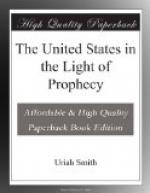That the leopard beast represents ecclesiastical as well as civil power is further shown in the arguments already presented to prove that this beast is identical with the little horn of Daniel’s fourth beast, which symbolizes the papacy in all its components parts and through all its history. It is the leopard beast alone that is identical with this little horn, not the leopard beast and the two-horned beast taken together.
Again, Pagan Rome gave its seat to the papacy. The dragon gave his seat to the leopard beast. If it takes both the leopard beast and the two-horned beast to constitute the papacy, the prophet should have said that the dragon gave his seat and power to these two beasts combined. The fact that his transfer was to the leopard beast alone, is proof positive that that beast alone symbolizes the papacy in its entirety.
When, therefore, John calls the two-horned beast “another beast,” it is certain that he does not mean any particular phase, or any part, of the papal power.
It is claimed by others that the two-horned beast represents England; by still others, France; and by some, Russia, &c. The first, among many other fatal objections to all these applications, is, that the territory occupied by all these powers is already appropriated by preceding symbols. If the two-homed beast symbolized any of these, it would be a part of other beasts instead of “another beast,” separate and distinct from all the rest. It is a law of symbols that each one occupies territory peculiarly its own; that is, the territory which constituted the original government, was no part of that which had been occupied by the previous powers. Thus Medo-Persia rose on territory not occupied by Babylon; and Medo-Persia and Babylon together covered all that portion of Asia known to ancient civilization. The Grecian or Macedonian kingdom arose to the west of them, occupying all Eastern Europe, so far as it was then known to the ancients. Rome arose still to the west, in territory unoccupied by Grecia. Rome was divided into ten kingdoms; but though Rome conquered the world, we look for these divisions only to that territory which had never been included in other kingdoms. We look not to Eastern Europe; for that was included in the dominion of the third beast: nor to Asia; for that constituted the empires of the first and second beasts: but to Western Europe, which territory was unoccupied till taken by Rome and its divisions.
The ten kingdoms which arose out of the old Roman Empire are enumerated as follows by Machiavel, indorsed by Bp. Newton, Faber, and Dr. Hales: 1. The Huns. 2. The Ostrogoths. 3. The Visigoths. 4. The Franks. 5. The Vandals. 6. The Suevi. 7. The Burgundians. 8. The Heruli. 9. The Anglo-Saxons, and 10. The Lombards. These kingdoms have since been known, says Scott, as the “ten kingdoms of the western empire,” and they are distinguishable at the present day, some of them even by their modern names, as Hungary from




